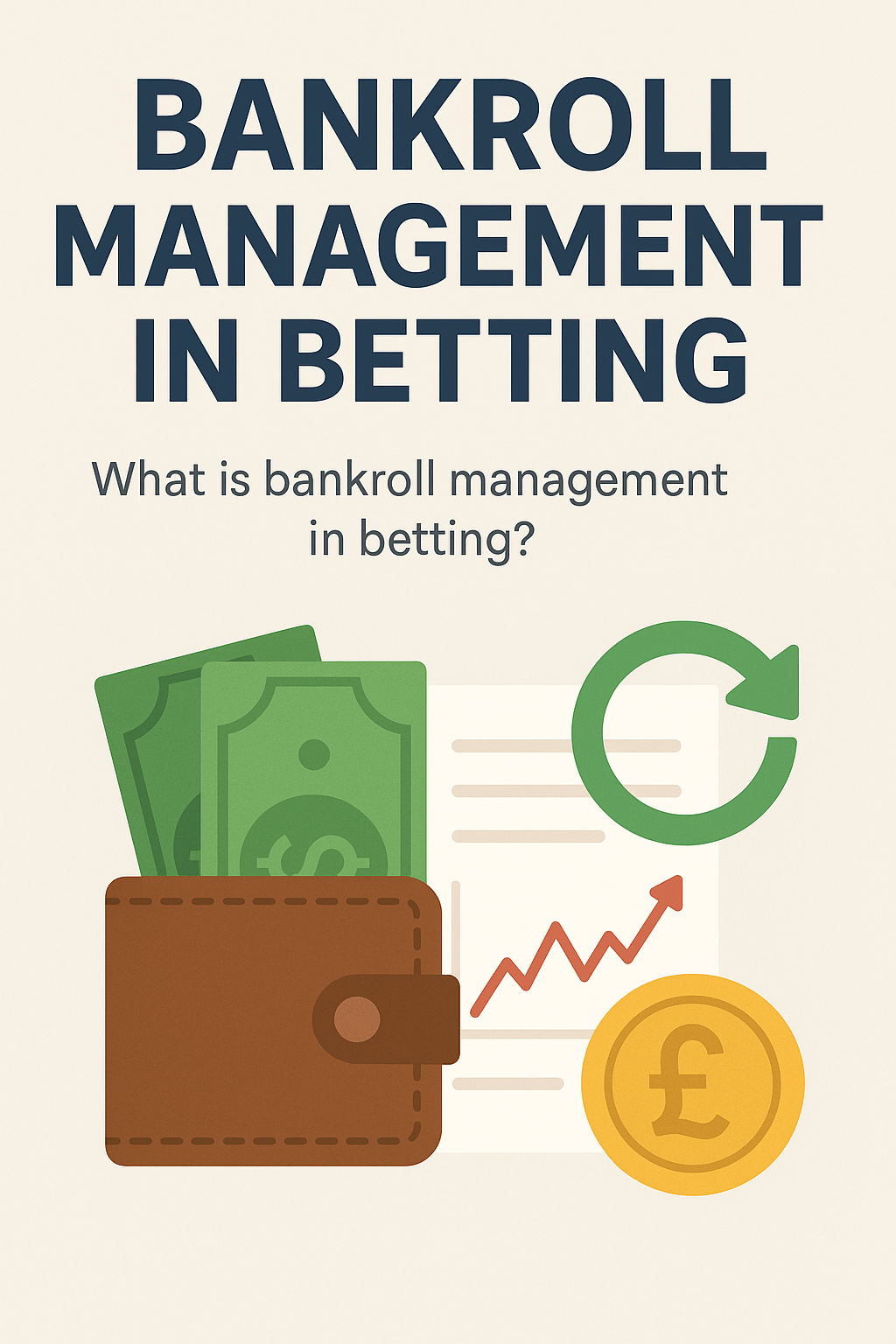Bankroll Management Betting: Our Guide for British Punters
Bankroll management is the backbone of smart betting. It can never be safe, but it can be safer. It’s about deciding how much to risk, when to stop, and how to make your money last. Whether you’re betting on football, horses, or casino games, mastering this simple skill keeps you in control – and in the game longer.

Introduction: What Is Bankroll Management in Betting?
Imagine walking into a bookie’s shop, or logging onto your favourite online bookmaker, with £100 in your pocket. You fancy a punt on the horses, maybe a cheeky accumulator on the Premier League, or perhaps a flutter on the roulette wheel.
Now ask yourself: How much should you bet on any single wager?
Without a plan, that £100 could vanish in the blink of an eye. This is where bankroll management comes in.
Bankroll management simply means deciding how much of your money you’re prepared to risk on each bet – and how you’ll protect yourself from going bust if you hit a losing streak.
It’s not just for high-rollers or professional gamblers. Whether you bet £1 a week or £1,000, bankroll management is one of the most important betting skills you’ll ever learn.
In this guide, we’ll break it all down:
- Why bankroll management matters
- Core principles like staking plans
- Real-life examples from UK sports and events
- Common mistakes punters make
- Practical tips for staying disciplined
- FAQs and real-world scenarios
By the end, you’ll have the tools to bet smarter – and keep the fun in betting.
Why Is Bankroll Management So Important?
Let’s start with the obvious question: Why bother managing your bankroll at all?
Here are three huge reasons:
1. To Avoid Going Bust
Every punter hits losing streaks. Even the sharpest pro bettors suffer runs where nothing goes their way. Without limits on how much you stake, you could burn through your betting funds in one bad weekend.
Example:
- You deposit £200 into your online account.
- You fancy a big win, so you put £100 on Arsenal to beat Man City at 3/1.
- Arsenal lose. You’ve wiped out half your balance in one bet.
Bankroll management ensures you’ll still have funds left to bet another day.
2. To Stay Calm and Avoid Chasing Losses
Bankroll management also protects your mental game. Betting is emotional. When you’re losing, it’s tempting to double your stake to “win it back.”
But chasing losses is the fast lane to empty pockets. If you stick to a plan, you’ll avoid emotional punts.
3. To Make Your Betting Sustainable
Even recreational punters want their betting money to last. Bankroll management keeps your punting fun and sustainable, so you’re not constantly topping up your account or gambling with money you can’t afford to lose.
Core Principles of Betting Bankroll Management
Let’s dive into the practical side: how do you actually manage a bankroll?
At its heart, bankroll management involves three key steps:
- Set Your Total Bankroll
- Choose a Staking Plan
- Adjust Based on Wins or Losses
Let’s explore each.
1. Setting Your Bankroll
Your bankroll is the pot of money you’ve put aside purely for betting. This should be money you can afford to lose – never money earmarked for rent, bills, or food.
Example:
- A casual punter might decide: “I’ll set aside £200 for betting over the next three months.”
- A more serious bettor might set aside £2,000 for the football season.
Think of your bankroll as your “betting business capital.” Once it’s gone, you’re out of the game.
2. Choosing a Staking Plan
This is where bankroll management becomes truly powerful.
A staking plan determines how much you bet on each wager. There are many approaches, but the key idea is simple:
- Don’t bet the same fixed amount on every bet without thinking.
- Instead, bet a small percentage of your bankroll.
The 1% to 5% Rule
A common guideline is to risk only 1% to 5% of your total bankroll per bet.
- If your bankroll is £500, betting 2% means staking £10 per bet.
- Even if you lose five bets in a row, you’ve only lost £50 – not your whole bankroll.
Most serious bettors stick to the lower end of that range, around 1% to 2%, especially if they’re betting odds like 3/1 or higher. If you want to learn more about odds, we created a whole “How to Understand Betting Odds” guide for new bettors.
Flat Betting vs Variable Staking
Two common approaches are:
- Flat Betting: You always bet the same amount (e.g. £10) regardless of how “confident” you feel. This keeps things steady and avoids emotional swings.
- Variable Staking: You adjust your stake based on your confidence level or the odds. For instance, you might bet more on odds-on shots and less on longshots.
Variable staking can be profitable but is riskier and requires strict discipline.
Kelly Criterion
The Kelly Criterion is a more advanced staking method that calculates exactly how much of your bankroll to stake based on your perceived edge over the bookmaker’s odds. However, it requires precise calculations and a genuine edge – so it’s generally best left to experienced punters.
3. Adjusting Your Bankroll
Many punters adopt rules like:
- Stop if you lose 20% of your bankroll.
- Withdraw winnings if you go up 50%.
These “stop-loss” or “profit-take” rules help you protect your funds and avoid giving winnings back in a sudden losing streak.
Practical Examples of Bankroll Management
Let’s look at how these principles play out in real UK betting scenarios.
Example 1: The Cheltenham Festival
- You set a £300 bankroll for Cheltenham week.
- You decide to bet 2% per race = £6 per bet.
- Over 20 bets, you risk £120 in total, leaving plenty of cushion for losses.
- Even if your first 8 bets lose, you’ve only lost £48 – not the whole £300.
Compare that to staking £50 a race: just six losers would wipe you out.
Example 2: Premier League Accumulators
Suppose you like doing £5 accas on weekends.
- You have a £200 bankroll.
- £5 is 2.5% of your bankroll – perfectly acceptable.
- If you lose four accas in a row, that’s £20 lost – only 10% of your total fund.
Without bankroll management, many punters get carried away and whack £50 on an accumulator because they fancy the odds – risking a quarter of their entire bankroll on a single bet.
Example 3: Casino Roulette
Even casino games need bankroll rules.
- You bring £100 to play roulette.
- You decide never to stake more than £2 per spin.
- That’s a 2% stake per bet, giving you at least 50 spins and time to enjoy the game.
Common Bankroll Management Mistakes
Even seasoned punters slip up. Here are some of the biggest traps:
Mistake 1: Chasing Losses
Perhaps the most classic error. You lose £20 and stake £40 on the next bet to “win it back.” This can spiral fast.
Mistake 2: Betting Too Large a Percentage
Betting 20% or more of your bankroll on a single wager can lead to ruin. One big loss wipes out your funds.
Mistake 3: No Plan at All
Many punters simply bet “what feels right.” That’s not a strategy – it’s gambling blind.
Mistake 4: Ignoring Bankroll Growth
If your bankroll grows from £200 to £400, you should recalculate your stakes. Many punters keep betting the same small amount, missing the chance to scale up responsibly.
Practical Tips for Bankroll Management
Here’s how to keep your betting bankroll healthy:
- ✅ Set a clear bankroll size – Decide how much you can afford to lose.
- ✅ Use a percentage-based staking plan – Stick to small percentages per bet.
- ✅ Track your bets – Keep a spreadsheet of every bet placed, stake, odds, and result.
- ✅ Set limits on losses and withdrawals – Know when to stop for the day.
- ✅ Stay disciplined – Don’t adjust your stakes on a whim.
- ✅ Separate bankrolls – Keep sports betting funds separate from casino funds if you do both.
Bankroll Management in the Age of Online Betting
Online betting makes bankroll discipline both easier and harder.
Easier because:
- You can check your balance instantly.
- Online accounts let you set deposit limits.
- Betting logs help you track your results.
Harder because:
- Betting apps make it easy to deposit more money in seconds.
- Instant cash-out features tempt impulsive decisions.
- Promotions and bonuses can lure you into bigger stakes.
Always use online tools like deposit limits, time-outs, and reality checks to help maintain bankroll discipline. More on How to Bet Online in our guide.
Mini Case Study: Joe’s Cheltenham Festival
Joe loves Cheltenham. He sets aside £500 as his festival bankroll. Instead of lumping £100 on the first day’s big fancy, he sticks to £10 bets (2% of bankroll).
By Day 3, he’s £80 down. Thanks to small stakes, he still has £420 left and lands a 12/1 winner. Joe finishes Cheltenham £40 up – a modest profit, but more importantly, he never risked blowing his full £500.
Had he staked £100 per bet, he’d have been out after five losers.
The Bottom Line
Bankroll management isn’t glamorous, but it’s one of the most powerful tools in betting. Whether you’re punting on the Grand National, backing your football team, or spinning the roulette wheel, controlling your stakes is what keeps betting sustainable – and enjoyable.
Remember:
- Decide how much you can afford to lose.
- Stick to low percentage stakes.
- Avoid chasing losses.
- Keep records.
Betting should be fun – and bankroll management helps keep it that way.
Where to go next on our site
- Our Betting Glossary and betting terms explained for the UK
- Best betting sites in the UK – tested and verified reviews of the best bookmakers in the UK,
- Best free bets offers – clear analysis of self-tested welcome offers for new customers,
- Football betting guides – bookmakers reviews on football and soccer betting.
Safer‑gambling resources
- GAMSTOP self‑exclusion – register free to block online gambling accounts. (Gambling Commission)
- National Gambling Helpline (GamCare) – 0808 8020 133, 24/7. (GamCare)
- NHS: Help for problems with gambling – official support and clinic info. (nhs.uk)
- GambleAware – advice, tools and signposting to treatment. (GambleAware)
Compliance note on scope: This guide focuses on Great Britain under the Gambling Act 2005, regulated by the UK Gambling Commission. If you’re in Northern Ireland, check local arrangements before you bet.
This guide was created with AI assistance and reviewed by a human editor to ensure accuracy and clarity. It is intended for informational purposes only and does not encourage gambling.
FAQs About Bankroll Management
Can bankroll management guarantee profit?
No. It reduces your risk of going bust but doesn’t eliminate the chance of losing money. There’s no magic bullet to beat the bookies.
What percentage should I stake per bet?
Many experts recommend 1% to 2% of your bankroll for each bet, especially if you’re betting higher odds.
Should I separate casino and sports betting bankrolls?
Yes. They’re different types of risk. Keep separate pots for clarity.
How often should I review my bankroll?
Ideally monthly. Adjust your staking plan if your bankroll has significantly grown or shrunk.






